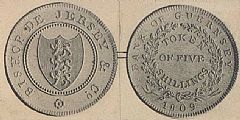Famous coin comes home, February 1951
'Described as of the highest rarity.' The Guernsey Press, 20th February 1951. Photographs from Carey Curtis Scrapbook p. 81, Staff, in the Library.

When one reads and hears much about the antiques leaving our own island and other places it is pleasant to record the return to its native land, after an absence of more than 140 years, of the only silver piece ever struck for use in Guernsey.
It is described in sale catalogues as being 'of the highest rarity' and 'excessively rare,' and that this description is, indeed, a fitting one is evidenced by the fact that there are not more than two specimens known to be in existence, one of which is in the British Museum and the other, represented by the photographs, now published for the first time.
These show the obverse and reverse sides of the coin, the value of which now runs into three figures. This silver token was only the second one of the 19th century, the first being a 6s. one struck for Ireland. These crowns were overstruck on Spanish 8 reales, commonly known as dollars, and were furnished by Boulton and Watt Ltd, of Birmingham, the ancestor of the Mint, which strikes our present coinage.
This 5s. piece was at once banned by the States, and now ranks, as such, a great rarity. Our legislation forbidding the use of this token is to be found in an Ordonnance of 2nd October, 1809. A full description of this coin may be found in 'The Coinages of the Channel Islands,' published in the Transactions of La Société Guernesiase for 1948. Descriptions may also be found in Nineteenth Century Tokens of the Possessions and Colonies of the British Empire, by W J Davis, and in Coins and Tokens of the British Empire, by James Atkins. Both of these works are to be found in the Priaulx Library.¹
First Bankers
Bishop, de Jersey and Co., were our first bankers and were in existence for about 10 years. They issued £1 notes. Mon Plaisir at St Jacques was the residence of the de Jersey family, and the Bishops were also of Guernsey, descendants of both being still in the island.
As the purchaser of this island treasure desires to remain anonymous the photographs (see above) are published to enable islanders to see the appearance of this beautiful and perfect specimen.
Incidentally, it is only two or three years ago that a Guernsey numismatist sold his collection for several thousand pounds.
¹ Actually Nineteenth Century Token Coinage of Great Britain, Ireland, the Channel Islands and Isle of Man, London: 1905. Both volumes remain available to consult in the Library, along with many other works on Channel Island numismatics. S Carey Curtis, in his article, 'The Currency of Guernsey,' in the 1992 Report and Transactions of the Guernsey Society, p. 105, talks about this token, adding that 'a fine specimen was a few months ago sold at Sotheby's for £42 to Messrs Spink, the well-known dealers, by whose courtesy I am able to give a full-size illustration of it.' The photograph is the same as the one above.
